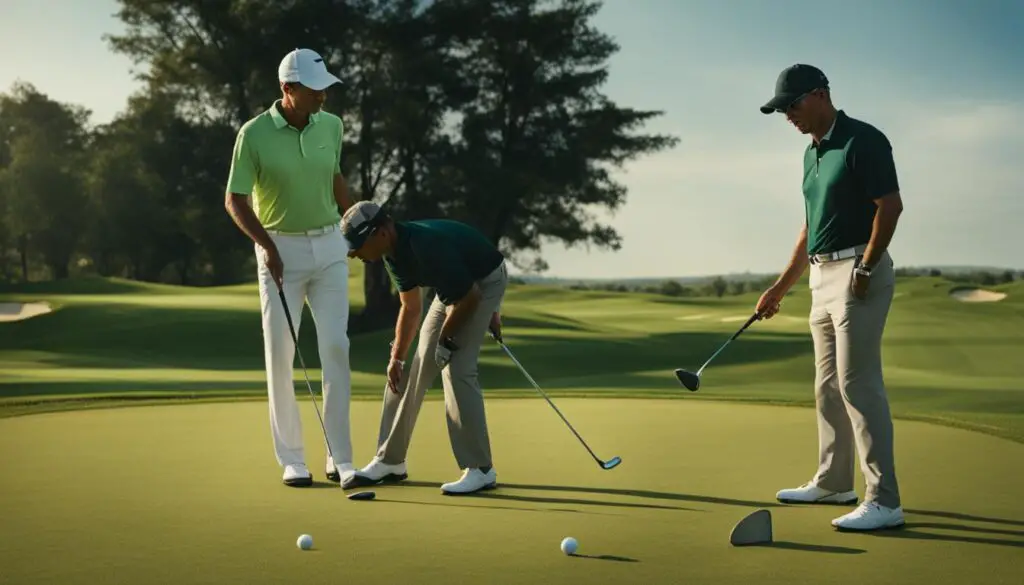Welcome to our comprehensive guide on mastering the golf swing! Whether you’re a beginner or an experienced golfer, understanding and perfecting your golf swing is the key to unlocking your full potential on the course. In this article, we will walk you through the essential techniques, tips, and strategies for achieving an effective golf swing.
But first, let’s dive into the fundamentals of a good golf swing. From grip and stance to swing mechanics and follow-through, we will cover it all. So grab your clubs, and let’s get started on your journey to becoming a master of the golf swing!
Key Takeaways:
- Mastering the golf swing requires time, practice, and dedication.
- A proper grip and stance are crucial for a successful golf swing.
- Understanding the mechanics behind the golf swing improves technique and consistency.
- The backswing, downswing, and follow-through are essential components of a powerful swing.
- Consistency in posture, grip, and impact position is key to building a reliable golf swing.
The Importance of Proper Grip and Stance
When it comes to mastering your golf swing, one of the key factors to consider is the importance of proper grip and stance. These two elements play a crucial role in achieving an effective and consistent swing. A good grip allows for control of the club head, while a balanced stance helps maintain stability throughout the swing.
For a proper grip, it is important to hold the club with a firm but not overly tight grip. This allows for proper control and flexibility during the swing. Additionally, the feet should be positioned shoulder-width apart, with the weight evenly distributed between both feet. This balanced stance provides a solid foundation for generating power and maintaining balance throughout the swing.
By focusing on maintaining a proper grip and stance, you can greatly improve the overall quality of your golf swing. These foundational elements provide the stability and control necessary to achieve a consistent and effective swing, leading to improved accuracy and distance on the course.
Tips for Proper Grip and Stance:
- Hold the club with a firm but not overly tight grip
- Position the feet shoulder-width apart
- Distribute the weight evenly between both feet
Golf Swing Mechanics: Unlocking the Secrets to a Perfect Swing
Mastering the golf swing requires a deep understanding of the mechanics behind it. By delving into the intricacies of the golf swing technique, you can unlock the secrets to a more powerful and accurate swing. The golf swing is a complex combination of body movements, weight transfer, and club path, all working together to generate the desired outcome. Let’s explore some key elements of golf swing mechanics that will help you elevate your game.
The Importance of Body Rotation
One crucial aspect of the golf swing is body rotation. As you initiate your swing, your torso, hips, and shoulders should rotate together to create a coiled energy. This rotational movement generates power and enables you to unleash the clubhead with maximum force. Practice drills that focus on proper body rotation, such as the “X-Factor” drill, can help you develop the necessary flexibility and coordination for an effective swing.
Understanding Weight Transfer
Another essential component of golf swing mechanics is weight transfer. Throughout the swing, your weight should transition from your back foot to your front foot. This transfer of weight initiates the downswing and adds momentum to your swing, resulting in greater clubhead speed. To train your weight transfer, practice drills that emphasize shifting your hips and maintaining a balanced stance. The “Step Drill” is a great way to develop a smooth weight transfer and improve your swing consistency.
Mastering the golf swing is a continuous process that requires dedication and practice. By understanding the fundamentals, practicing drills and exercises, and seeking professional guidance, you can improve your golf swing and elevate your game
The Path of the Club
Finally, the path of the club is a fundamental aspect of golf swing mechanics. The club should follow a proper path during the swing to ensure a square impact with the ball. To achieve this, focus on a smooth takeaway, keeping the club on the proper plane throughout the swing, and maintaining a square clubface at impact. Practice drills such as the “Gate Drill” or using alignment rods can help you develop the correct club path and improve your ball-striking consistency.
Understanding and refining the mechanics of your golf swing can have a significant impact on your overall performance on the course. By honing your body rotation, mastering weight transfer, and focusing on the path of the club, you can unlock the potential of a near-perfect swing. Remember, consistency comes with practice, so be patient and dedicated to your improvement. With time and effort, you’ll see your golf swing transform and your scores improve.

Developing a Solid Backswing
To master the art of the golf swing, it is essential to develop a solid backswing. The backswing sets the foundation for the entire swing, positioning the club and body for a powerful and accurate strike. By focusing on proper technique and incorporating specific drills into your practice routine, you can improve your backswing and elevate your overall golf game.
One key aspect of a solid backswing is the rotation of the shoulders, hips, and torso. This rotational movement allows for a full coil and generates the potential energy needed for an effective downswing. To practice this rotation, you can try the “shoulder turn drill.” Stand in your golf setup position, place a club across your shoulders, and rotate your upper body as far as possible while maintaining balance and posture. This drill helps build flexibility and muscle memory for a proper backswing.
Another important component of the backswing is maintaining a smooth tempo. Rushing or jerking the club during the backswing can lead to inconsistency and loss of power. To develop a smooth backswing, try the “Step-by-Step Tempo Drill.” Begin by taking the club back slowly and smoothly, focusing on a fluid motion. Gradually increase your speed while maintaining control and balance. This drill helps train your muscles to execute a consistent and controlled backswing.
It is also beneficial to practice drills that focus on specific elements of the backswing, such as wrist hinge and clubface alignment. These drills help refine your technique and promote a more efficient and powerful swing. Additionally, incorporating video analysis into your practice sessions can provide valuable feedback on your backswing mechanics and allow for necessary adjustments.
By dedicating time and effort to developing a solid backswing, you can greatly improve the overall quality of your golf swing. Remember to focus on rotational movement, maintain a smooth tempo, and incorporate specific drills into your practice routine. With consistent practice and attention to technique, your backswing will become a powerful foundation for a successful golf swing.
Mastering the Downswing
The downswing is a critical phase of the golf swing that requires precision and technique. It is the transition from the backswing to the point of impact, where the clubhead accelerates and makes contact with the ball. Mastering the downswing is essential for generating power, accuracy, and consistency in your golf swing.
One important aspect of the downswing is shifting your weight properly. As you initiate the downswing, transfer your weight from your back foot to your front foot. This weight shift helps create a smooth and powerful swing motion, allowing you to generate maximum clubhead speed at impact. Additionally, it is crucial to maintain a steady head position throughout the downswing, keeping your eyes focused on the ball.
Timing is another key factor in the downswing. The release of the club should be timed correctly to ensure a solid strike. The release occurs naturally as you rotate your hips and unwind your upper body, allowing the club to square up at impact. Practice drills that emphasize timing and synchronization of the body can help you refine your downswing and improve your ball-striking ability.
Common Mistakes to Avoid in the Downswing
During the downswing, it is important to avoid common mistakes that can negatively impact your golf swing. One common mistake is a premature release, where the clubhead is released too early, resulting in a weak and inconsistent shot. Another mistake is an over-the-top swing, where the club moves outside the desired swing plane, causing slices or pulls. It is crucial to maintain an inside-out swing path for better accuracy and distance.
To analyze your downswing and identify areas for improvement, consider seeking professional golf swing analysis. A golf instructor or coach can provide valuable insights, helping you pinpoint any flaws or inefficiencies in your downswing technique. They can offer personalized guidance and drills to address specific issues and help you streamline your downswing for optimal performance on the course.

Remember, mastering the downswing takes time, practice, and patience. Focus on proper weight transfer, timing, and avoiding common mistakes. By refining your downswing technique, you can enhance your golf swing and take your game to the next level.
Perfecting the Follow-Through
The follow-through is a critical component of a successful golf swing. It not only completes the motion but also plays a key role in maximizing control and power. To perfect your follow-through, focus on a few key techniques and incorporate specific drills into your practice routine.
Maintaining Balance and Stability
One important aspect of the follow-through is maintaining your balance and stability throughout the swing. As you strike the ball, transfer your weight onto your front foot and keep your body balanced. This will ensure a smooth and controlled follow-through, allowing you to maintain accuracy and distance.
Extending Your Arms
Another crucial element of the follow-through is extending your arms fully after impact. This extension allows for maximum control and power, enabling you to achieve distance and accuracy in your shots. Practice drills that focus on extending your arms and maintaining a relaxed grip to improve your follow-through technique.
“The follow-through is like the punctuation mark at the end of a sentence. It completes your swing and sends a message to the ball.”
By incorporating follow-through drills into your practice routine, you can improve the consistency and effectiveness of your golf swing. Work on maintaining balance and stability, extending your arms fully, and staying relaxed throughout the follow-through. With dedicated practice, you’ll be able to perfect your follow-through technique and enhance your overall golf game.
Building Consistency in Your Golf Swing
Consistency is the holy grail of a perfect golf swing. It allows you to repeat your best shots time and time again, leading to improved accuracy and distance. To build consistency in your golf swing, there are a few key tips to keep in mind.
- Maintain a consistent posture: A proper posture sets the foundation for a solid golf swing. Make sure your spine is straight, your knees slightly flexed, and your weight evenly distributed between your feet. Consistently maintaining this posture throughout your swing will help improve your balance and control.
- Focus on your grip pressure: The grip is your only connection to the club, so finding the right balance of grip pressure is crucial. A grip that is too tight can restrict your swing and lead to tension, while a grip that is too loose can cause you to lose control. Experiment with different grip pressures until you find the sweet spot that allows for a smooth and consistent swing.
- Pay attention to your impact position: The position of the clubface at impact greatly affects the direction and trajectory of your shots. Consistently practicing and refining your impact position will help ensure a square clubface and more accurate shots. Focus on keeping your hands ahead of the clubhead at impact to promote a solid strike.
- Develop a practice routine: Consistency in golf swing comes with regular practice. Set aside dedicated practice time each week to work on your swing mechanics and drills. Developing a practice routine will help reinforce muscle memory and build consistency over time.

Remember, building consistency in your golf swing takes time and patience. It’s important to approach each practice session with a positive mindset and focus on the process rather than the outcome. By implementing these tips and dedicating yourself to practice, you’ll be well on your way to achieving a more consistent and perfect golf swing.
The Most Common Mistakes Beginners Make When Swinging a Golf Club
Whether you’re a beginner or an experienced golfer, mastering the golf swing can be challenging. For beginners, it’s important to be aware of the most common mistakes that can hinder your progress. By understanding these mistakes and working on the fundamentals, you can improve your golf swing and set yourself up for success on the course.
Improper Grip:
One of the most common mistakes beginners make is having an improper grip. A proper grip provides control and stability during the swing. Avoid gripping the club too tightly or too loosely. Instead, aim for a firm but relaxed grip, allowing for flexibility and control.
Incorrect Alignment:
Alignment is crucial for a successful golf swing. Beginners often struggle with aligning their body properly to the target. Make sure your feet, hips, and shoulders are aligned parallel to the target line. This will help you swing on the correct path and increase your chances of hitting the ball straight.
Lack of Rotation:
Rotation plays a key role in generating power and accuracy in the golf swing. Many beginners fail to rotate their body fully, leading to a lack of distance and control. Focus on rotating your shoulders, hips, and torso throughout the swing. This will help you generate more power and achieve a consistent swing.
“Developing a solid foundation in grip, alignment, and rotation is essential for beginners looking to improve their golf swing.”
Remember, everyone makes mistakes when learning something new, and golf is no exception. By being aware of these common mistakes and actively working on correcting them, beginners can make significant progress in their golf swing. Practice regularly, seek guidance from a professional instructor, and be patient with yourself. With time and dedication, you’ll be well on your way to mastering the art of the golf swing.
The Benefits of Golf Instruction and Lessons

Are you looking to improve your golf swing and elevate your game? Consider the benefits of golf instruction and lessons. Whether you’re a beginner or an experienced golfer, working with a professional instructor can provide valuable guidance and feedback on your technique and mechanics.
One of the main advantages of golf instruction is the personalized approach. A professional instructor can analyze your swing and identify any flaws or areas for improvement. They can then offer tailored instruction and drills to help you address those specific issues, whether it’s correcting your grip, refining your backswing, or improving your weight transfer.
The Benefits of Golf Instruction
Golf lessons also provide a structured learning environment. With regular lessons, you’ll have a clear practice plan and goals to work towards. This structure can help you stay motivated and focused on your improvement. Plus, having a dedicated time and place for instruction allows you to fully immerse yourself in the learning process.
Working with a professional can help you avoid bad habits and develop good ones from the start. They can guide you through proper warm-up exercises, teach you how to analyze your game, and offer strategies for self-correction on the course. With their expertise, you’ll be able to progress more quickly and efficiently.
Lastly, golf instruction can enhance your overall enjoyment of the game. As you improve your swing and see your scores drop, you’ll experience a greater sense of satisfaction and fulfillment. The guidance and support of a professional instructor can make the learning journey enjoyable and rewarding.
So, whether you’re looking to fix a specific flaw in your swing or take your game to the next level, consider investing in golf instruction and lessons. The expertise and personalized instruction you’ll receive can greatly accelerate your progress and help you become a more confident and skilled golfer.
Strategies for Improving Your Golf Swing
If you want to take your golf swing to the next level, consistent practice is key. But how do you make the most of your practice sessions? Here are some strategies that can help you improve your golf swing:
1. Utilize Training Aids
Training aids, like the Lag Shot, can be valuable tools for refining your technique. These aids provide feedback and help you develop a more consistent swing plane, tempo, and release. Incorporating training aids into your practice routine can help you groove the correct motions and build muscle memory for a more repeatable swing.
2. Focus on Swing Plane Drills
The swing plane is the path the club travels during the swing. To improve your swing plane, try incorporating drills that promote proper club path and alignment. For example, using alignment sticks or a swing plane trainer can help you develop a more efficient and on-plane swing.
3. Work on Weight Transfer
Proper weight transfer is essential for generating power and consistency in your swing. Practice drills that focus on shifting your weight from your back foot to your front foot as you swing. This transfer of weight helps to create a more powerful downswing and can lead to more solid contact with the ball.
With these strategies, you can work towards improving your golf swing and perfecting your game. Remember, consistency and dedication are key to achieving a more accurate and powerful swing. So, get out on the course, put these strategies into practice, and watch your game soar!
The Power of Visualization in Golf
Visualization is a powerful tool that can greatly enhance your golf swing. By harnessing the power of your mind, you can improve your focus, consistency, and overall performance on the course. When you visualize your golf swing, you mentally rehearse the desired outcome, allowing your body to follow suit.
Imagine yourself standing on the tee, preparing to take your swing. Close your eyes and vividly picture the perfect swing, feeling the club in your hands, the smooth rotation of your body, and the sound of the club making contact with the ball. By visualizing this successful swing, you are programming your mind to execute it with precision.
Visualization can also help you overcome obstacles and challenges on the course. If you’re struggling with a particular aspect of your swing, such as accuracy or distance, visualize yourself addressing and conquering those areas. See yourself hitting the ball straight down the fairway or sticking it close to the pin. This mental imagery will help build confidence and belief in your abilities.
Tips for Effective Visualization:
- Find a quiet and comfortable space where you can relax and focus.
- Clear your mind of any distractions and worries.
- Close your eyes and begin to visualize your ideal golf swing.
- Engage all your senses – feel the grip, hear the sound, and see the ball soar through the air.
- Repetition is key – practice visualization regularly to reinforce positive images and routines.
- Incorporate visualization into your pre-shot routine to create a seamless transition from mental preparation to physical execution.
Visualization is like a mental golf simulator. It allows you to mentally rehearse your swing and envision success before it even happens. By incorporating visualization into your practice routine, you can develop a more confident and consistent golf swing.
Remember, visualization is just one component of a successful golf swing. It is essential to combine it with proper technique, practice, and a positive mental approach. When you integrate visualization into your golf routine, you tap into the power of your mind, unlocking your true potential on the course.

Seeking Professional Help for Golf Swing Improvement
If you’re serious about improving your golf swing, seeking professional help from a qualified golf instructor or coach can make a significant difference. They have the expertise and experience to analyze your swing and provide personalized instruction tailored to your specific needs. A golf swing coach can help identify any faults in your technique and work with you to correct them, leading to a more efficient and consistent swing.
Professional golf instruction goes beyond just analyzing your swing mechanics. A golf coach can also offer valuable guidance on other aspects of the game, such as strategy, mental approach, and course management. They can help you develop effective practice routines and provide feedback to help you stay on track with your improvement goals.
Working with a golf swing coach not only provides technical instruction but also serves as a source of motivation and accountability. They can push you to challenge yourself and overcome any mental or physical barriers that may be holding you back. With their guidance, you can accelerate your progress and achieve your desired level of performance on the course.
Benefits of Professional Golf Instruction:
- Personalized instruction tailored to your specific needs
- Expert analysis of your swing mechanics
- Guidance on strategy, mental approach, and course management
- Development of effective practice routines
- Motivation and accountability
Working with a professional golf instructor or coach can greatly enhance your golf swing and overall game. Their expertise, personalized instruction, and guidance can help you overcome challenges, refine your technique, and achieve your desired level of performance. Don’t hesitate to seek professional help if you’re serious about improving your golf swing; it may be the key to unlocking your full potential on the course.

Master Your Golf Swing and Elevate Your Game
Are you looking to improve your golf swing and take your game to the next level? Mastering the golf swing is a continuous process that requires dedication and practice. By understanding the fundamentals and mechanics of the golf swing, you can make significant improvements and achieve a more accurate and powerful swing.
Understanding the golf swing mechanics is crucial for improving technique and consistency. It involves proper posture, grip, backswing, downswing, weight shift, and rotation. By focusing on each of these components and practicing drills that target specific areas, you can refine your technique and achieve a more efficient and effective swing.
While self-practice is important, seeking professional guidance can also greatly enhance your golf swing. Working with a qualified golf instructor or coach can provide personalized instruction, analysis of your swing, and valuable feedback tailored to your specific needs. With their guidance and expertise, you can identify and correct swing faults, refine your technique, and elevate your overall performance on the course.
Remember, improving your golf swing takes time and consistent effort. By dedicating yourself to mastering the fundamentals, practicing drills and exercises, and seeking professional help when needed, you will gradually see progress and achieve a more powerful and accurate golf swing. So get out there, keep practicing, and elevate your game!
FAQ
What is the key to a good golf swing?
The key to a good golf swing is proper grip and stance, along with understanding the mechanics of the swing.
How do I improve my grip and stance?
To improve your grip, hold the club firm but not too tight, and for your stance, make sure your feet are shoulder-width apart with the weight evenly distributed.
What are the components of a golf swing?
A golf swing involves proper posture, grip, backswing, downswing, weight shift, and rotation of the body.
How can I develop a solid backswing?
Practicing drills that focus on specific components of the backswing can improve accuracy and technique.
What is the importance of the downswing?
The downswing is crucial for generating power and accuracy in your golf swing.
How can I perfect my follow-through?
By shifting your weight onto the front foot, extending your arms, and maintaining a relaxed grip, you can achieve a powerful follow-through.
How can I build consistency in my golf swing?
Consistency can be achieved by maintaining a consistent posture, grip pressure, and impact position, and by developing a practice routine.
What are the most common mistakes beginners make in their golf swing?
Common mistakes include improper grip, incorrect alignment, and lack of rotation.
How can golf instruction and lessons help improve my swing?
Golf instruction and lessons provide valuable guidance, personalized instruction, and feedback on technique and mechanics.
What strategies can I use to improve my golf swing?
Regular practice, utilizing training aids, practicing swing plane drills, weight transfer exercises, and impact bag drills can all improve your golf swing.
How can visualization enhance my golf swing?
By visualizing the desired outcome and imagining yourself performing a successful swing, you can enhance your focus and consistency on the course.
Why should I seek professional help for golf swing improvement?
Professional instructors can identify and correct swing faults, refine technique, and offer personalized tips tailored to your specific needs.
How can I master my golf swing and elevate my game?
By understanding the fundamentals, practicing drills and exercises, and seeking professional guidance, you can improve your golf swing and achieve a more accurate and powerful game.
